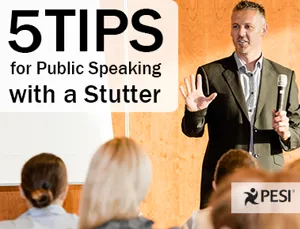5 Tips for Public Speaking with a Stutter

If you were to ask someone what they’re afraid of, you’re likely to hear some common answers: spiders, snakes, heights, and public speaking. But for those who stutter, the fear of public speaking can be amplified by their anxiety about stuttering. I have a unique perspective about this fear. Not only do I teach public speaking at the college level, present across the country, and work as a speech pathologist in my own private practice, but I stutter.
Here are my 5 tips for helping your clients who stutter become more comfortable with public speaking.
1. Encourage your client to pick a topic they are passionate about
When I first began public speaking, I was addressing Mothers’ Groups about language development in children. I would become so passionate about my topic that I would sometimes forget about my stuttering. Having clients pick topics that are meaningful and enjoyable for them doesn’t mean they won’t stutter, but they will have greater enjoyment in the experience of communication.
In addition, if you are working with students, you may want to encourage them to pick the topic of stuttering. One high school student told me he didn’t have to hide his stuttering anymore, and it was easier to talk because his class better understood his communication disorder after he did his class presentation on stuttering.
2. Have your client acknowledge their stuttering in the presentation
I begin presentations by saying, “I want to let you know I stutter, and I may need a minute from time to time to say certain words.” Your client can provide more details about their stuttering, depending on their comfort level.
3. Practice in the actual room where the presentation will be given
I have used this technique many times especially when doing big presentations. The most challenging and gratifying speech that I ever had to give was my father’s eulogy. The night before, I practiced in the empty church. It enabled me to face my fears of going up to the podium, check the sound of the microphone, and know where I would place my notes. On the actual day of the funeral, I felt empowered and confident because I had already been there.
Going up to the podium or in front of the classroom can be nerve-wracking, but if clients have already been there, they will feel more confident when they have to do it for “real.”
4. Role-play worst case scenario with your client
When your client shows you what they are afraid of happening on the day of the presentation, it can help you prepare by knowing what to do if the situation happens. If having a significant moment of stuttering is the fear, then have your client stutter on purpose, and show 30 seconds of the presentation in that way. If they are afraid of being laughed at, then you may role-play this situation. If they have already experienced worst case scenario, the actual presentation will feel less intimidating.
5. Have your client practice basic communication skills in addition to speech strategies for stuttering
In addition to working on speech strategies for stuttering, you should also address basic communication skills such as eye contact with the audience, vocal volume and proper inflection in the voice to emphasize key points. Practicing these skills can instill confidence and enable your clients to be a more engaging speaker.
This post has been brought to life by PESI speaker Marilee Fini, MA, CCC-SLP.
Here are my 5 tips for helping your clients who stutter become more comfortable with public speaking.
1. Encourage your client to pick a topic they are passionate about
When I first began public speaking, I was addressing Mothers’ Groups about language development in children. I would become so passionate about my topic that I would sometimes forget about my stuttering. Having clients pick topics that are meaningful and enjoyable for them doesn’t mean they won’t stutter, but they will have greater enjoyment in the experience of communication.
In addition, if you are working with students, you may want to encourage them to pick the topic of stuttering. One high school student told me he didn’t have to hide his stuttering anymore, and it was easier to talk because his class better understood his communication disorder after he did his class presentation on stuttering.
2. Have your client acknowledge their stuttering in the presentation
I begin presentations by saying, “I want to let you know I stutter, and I may need a minute from time to time to say certain words.” Your client can provide more details about their stuttering, depending on their comfort level.
3. Practice in the actual room where the presentation will be given
I have used this technique many times especially when doing big presentations. The most challenging and gratifying speech that I ever had to give was my father’s eulogy. The night before, I practiced in the empty church. It enabled me to face my fears of going up to the podium, check the sound of the microphone, and know where I would place my notes. On the actual day of the funeral, I felt empowered and confident because I had already been there.
Going up to the podium or in front of the classroom can be nerve-wracking, but if clients have already been there, they will feel more confident when they have to do it for “real.”
4. Role-play worst case scenario with your client
When your client shows you what they are afraid of happening on the day of the presentation, it can help you prepare by knowing what to do if the situation happens. If having a significant moment of stuttering is the fear, then have your client stutter on purpose, and show 30 seconds of the presentation in that way. If they are afraid of being laughed at, then you may role-play this situation. If they have already experienced worst case scenario, the actual presentation will feel less intimidating.
5. Have your client practice basic communication skills in addition to speech strategies for stuttering
In addition to working on speech strategies for stuttering, you should also address basic communication skills such as eye contact with the audience, vocal volume and proper inflection in the voice to emphasize key points. Practicing these skills can instill confidence and enable your clients to be a more engaging speaker.
This post has been brought to life by PESI speaker Marilee Fini, MA, CCC-SLP.



